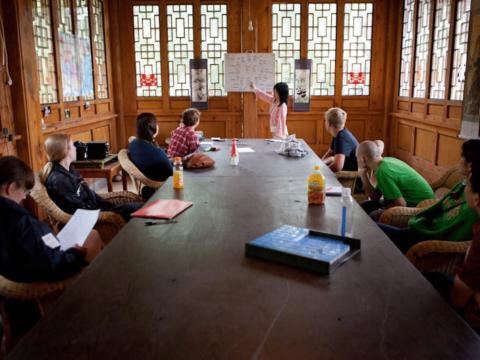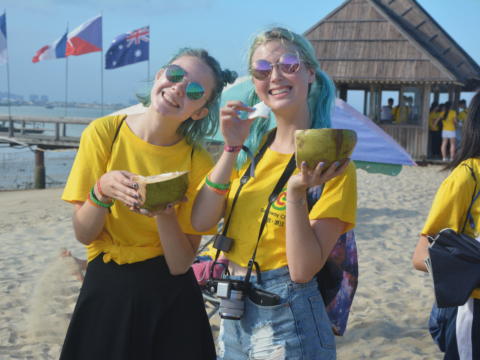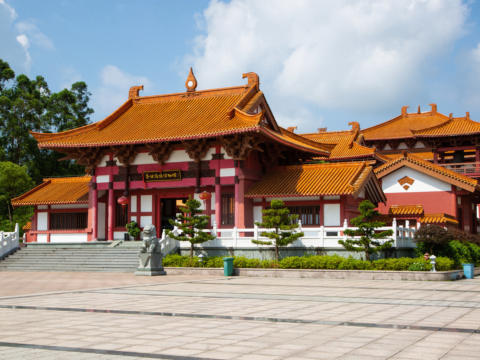Only 450€ per week!
Ocean Conservation
Donghai Island and Naozhou Island - China
Soak in Donghai Island’s scenic beach views while caring for China’s cute and endangered wildlife!
This Conservation program will have you helping protect its local sea turtles and dolphins. You’ll help maintain their environment, release animals back into their natural habitat. Together with local staff, you’ll learn more about them and help these endangered creatures and be a part of preserving their legacy to the earth.
Program Description
This conservation program is located in South China Sea, an island named Donghai Island, where you can both take care of turtles and know more about dolphins in one week.
The dolphin conservation is mainly to promote the idea of protecting dolphins in schools, helping the local center to build its dolphin museum, and rebuilding any housing damage from the annual typhoon.
Also you may have the chance to see dolphin by boat if you are lucky enough!!
There are 5 species of turtles that live in the South China Sea. This program breeds and cares after all of these 5 different species i.e. the:
- Leatherback
- Loggerhead
- Hauxville
- Green
- and Olive Ridley turtles
There are around 20 disabled turtles living in the centre at one time, and in a separate centre nearby there are several healthy turtles which will be released to the ocean when they recover
At certain times, you may witness the turtle eggs hatching, a beautiful experience, as they are released straight into the ocean when born like nature intended
If you not only love animals but would like to relax with some coastal sunshine and sand, this is the program for you!
Aims & Objectives
- Get a hands-on approach to help protect China’s injured sea-turtles
- Create a safe and clean environment for China’s dolphins
- To educate ourselves and others on the importance of ocean conservation
Schedule
Monday (Donghai Island)
- After breakfast you will transfer to Donghai Island,where you can visit dolphin and turtle conservation program
- Lunch
- In the afternoon, the staff in the dolphin conservation will give brief introduction to you about the area
- Dinner BBQ night in the beach
Tuesday (Donghai Island)
- Breakfast
- Take a boat to the sea and if you are lucky,you can see dolphins.After that you can take part in some fishing while you are on the boat
- Lunch in the center
- In the afternoon, help the local staff to rebuild the house and some construction work for the dolphin museum, and then cleaning dust bins on the beach
- Dinner
Wednesday (Donghai Island)
- Breakfast
- Help the local staff to rebuild the house and some construction work for the dolphin museum
- Lunch
- In the afternoon, visit the local school and teach them in the class about the knowledge of dolphin and how to protect them in the environment
Thursday (Naozhou Island)
- After breakfast ,you will transfer with public transportation to Naozhou Island
- Lunch in the island
- In the afternoon,you will visit the turtle conservation centre and help there
Friday (Naozhou Island)
- Breakfast
- In the morning, enjoy your time in the island and say goodbye to the turtles
- After lunch back to Zhanjiang, free time for relaxing
- City tour in Zhanjiang
- Dinner (self-organized)
- Sleepover in Zhanjiang
Note: This schedule can be changed and/or amended depending on weather conditions, local conditions and unforeseen circumstances.
Participant Criteria & Requirements
Standard Requirements
Minimum age: –
Maximum age: –
Minimum English level: Basic
CRB required: No
Passport copy required: No
Resume copy required: No
Required qualification: None
Additional Requirements
There are no specific participant requirements for this program.
Additional Equipment
No additional equipment is required.
Location
Donghai Island is an island in the southeast part of the urban area of Zhanjiang, it is the largest island in Guangdong and the fifth-largest island in China. It has a coastline of 160 km and with one of the longest sand beaches in the southern world at 28 km’s long. Wind and waves are frequent here so many enjoy plunges into in the sea, boat trips or fishing with the locals then eating the seafood on the beach…all of which make visitors reluctant to leave this picturesque region.
Our accommodation is set in a relaxing area that catches the beautiful sunrise, which you can enjoy while resting in the hammocks along the beach or by walking along the walk – on pier. It is close to the fishing village which regularly receives boats to and fro with busy fishermen.
About the Accommodation
You will be living on the site. You may need to to use squatting toilets during your stay here (a natural, healthier alternative!). Some hammocks are available for your use, and the simple surroundings will encourage a relaxing stay.
Food Arrangements
Three typical Chinese meals a day are provided and served at the dining hall. Being right next to various fisheries, expect a lot of fresh Seafood served to you, although vegetarian options are also available.
Facilities
Being a small Island, there is not much to expect. The fishing village here has some stores within walking distance, but for anything important or necessary, it is a 40 minute drive from Zhanjiang and the Airport.
Activities & Events
No scheduled activities outside the program.
Sights & Surroundings
Zhanjiang is the typical go-to place during your free time here, and is only 40 minutes away. Very different from Donghai’s simple surroundings, it is a full-on coastal city with much to do and see. Our coordinators like to call it the “Miami of China”!
Please ask your coordinator for help in organizing visits to these or any other places.
Transportation
From this location we provide free transport to your next program at the following location(s):
- Road Trip
- Zhanjiang
Location
This quiet, rural island gives you a fresh view of the ocean coastline.
About the Accommodation
This simple guesthouse offers you all the basics for your stay on this special little island. You’ll be bringing your belongings for this stay.
Food Arrangements
Being on a fishing island, enjoy plenty of seafood! Vegetarian options also available.
Facilities
Although a small island, there is restaurants, ATMs and mini mart nearby. A supermarket is in driving distance too.
Activities & Events
No scheduled activities outside the program.
Sights & Surroundings
We recommend nearby attractions for you to visit in your spare time like Naozhou Tower, Nayanhai Beach, and a special museum called the Arts of Song Dynasty.
Transportation
From this location we do not provide free transport to other locations.
Quick Facts
Name: People’s Republic of China
Population: 1.37 billion
Capital: Beijing
Language: Standard Chinese
Currency: Renminbi (Yuan) (CNY)
Time zone: CST (UTC +8)
Country Information
China covers approximately 9.6 million square kilometers making it the 2nd largest country by land area. It is not only the country with the largest population in the world but it is also one of the largest economies laying claim to being the world’s largest exporter and 2nd largest importer of goods.
It is a country of incredible cultural history boasting one of the earliest ancient civilisations dating back to around 2800 BC. Its landscape is equally rich in diversity, ranging from its forest steppes, its deserts in the north and subtropical forests in the south to its 14,500km long stretch of Pacific Ocean coastline. All of this makes China an incredible and exciting place to be, both in what it has to offer today and the story of its past.
Climate
Due to the vast expanse of land that China covers both in terms of longitude and latitude, the climate varies greatly from place to place. Generally, the climate pattern in China is characterised by dry seasons and wet monsoons. The rainy seasons mainly span from May to september but this pattern is less consistent in the some areas such as the dry northwest.
The difference in season causes a pronounced disparity in temperatures between winter and summer. Whilst the summer offers warm temperatures almost everywhere, the winter can cause temperatures to drop significantly, especially in the northern areas of China.
The Monsoon
The southern provinces start to experience the monsoons first, starting in April and May. The winds start to blow north in June meaning that northern provinces receive the rains around July and August, and the rains start to come to an end in September and are generally completely over in October. The northwest of China is the only area that avoids the monsoon climate.
Culture
China is one of four great ancient civilizations with 3,600 years of written history, and its culture both past and present is incredibly profound. Whilst Chinese cultural identity has many common, unifying elements, it is a country that represents 56 ethnic minority groups, the largest of which is the Han Chinese (900 million people), with other groups including the Tibetans, Mongols, Naxi etc. The significance of this is that each group to an extent creates their own culture and so within the vast expanse of China, depending on where you are, cultural variety is plentiful and there to be explored!
The country is currently ruled by The Chinese Communist Party. It is officially atheist, but is slowly and surely becoming more tolerant towards the practice of religion. The five official religions in China are Buddhism, Taoism, Islam, Catholicism and Protestantism. Due to the fact that it is only in recent years that tolerance of religion has made any progress, the practice of other religions is not formally recognised, although are often tolerated especially in the case of ancient Chinese beliefs. Currently about a quarter of the population practice Taoism, Confucianism and other traditional religions.
Gastronomy
There are 8 different styles of traditional Chinese cuisine, and traditional food can be found everywhere in China. Other styles adopted into Chinese cuisine and that might be found in China include Singaporean, Malaysian, Indonesian, Indian and American cuisine.
The staple foods used in Chinese cooking include exactly what you would expect: rice, noodles, and vegetables with sauces and seasonings.
The attitude regarding food in China is generally “waste not, want not” meaning that it not just uses a wide variety of both plants and animals, but every part of these plants and animals are used in some way. For westerners this might mean that there are a few things on the menu that you may not be used to and might want to avoid.
Due to the scale of the country, it isn't surprising that each area of China has a unique style of cooking and the ingredients very much depend on the natural agricultural produce of the specific region. For example the south of China uses far more rice than the north, where wheat is its main ingredient, a reason why noodles and dumplings are much more common. Southern food is also typically more spicy than that of the north.
Common Chinese dishes include: Sweet and Sour Pork, Gong Bao Chicken, Ma Po Tofu, Wontons, Dumplings, Chow Mein, Peking Roasted Duck and Spring Rolls
Transportation
Like its economy, China’s transportation network has rapidly expanded over recent years and now houses the longest road network in the world as well as the busiest train network
Air
Although the most expensive means of transportation, it is by far the most convenient and can save a lot of time travelling the longer distances across China.
The main ports of air travel are Beijing, Shanghai, Guangzhou and Hong Kong although all major cities within the country host domestic flights.
Rail
This is the primary mode of transportation in China and most major cities have their own metro systems. As well as its standard vast rail network, China boasts over 7000 km of high-speed rail.
Bus
For local travel, buses are a very affordable way of getting around and a good alternative mode of transport where metro is not available.
Taxi
Taxis are generally cheap and easy to find. Meters are generally used in towns and cities. If your driver does not want to use a meter, common for longer trips out of town, be sure to negotiate a price before the journey.
Other Alternatives
Motor pedicabs, pedicabs and motorbikes can all be found in China and are a cheap way of getting around. We recommend you set a price before using this form of transport.





